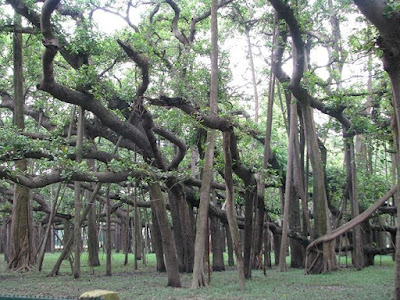Banyan tree
The metaphor of asvattha or banyan tree with its roots upwards and its branches downwards and its leaves the Vedic aphorisms. The roots above refer to the root of all the eternal Supreme Lord and the imperishable Atma or immortal soul. The branches downward refer to transitory living entities consisting of the devas headed by Brahma, who all have a finite span of life in material existence even if they live for millions and billions of years. Transitory is another meaning of asvattha and for the devotees of the Supreme Lord, the material world may not last even unto tomorrow. That which lasts until tomorrow is known as stvattha so asvattha is that which will not last until tomorrow. It is avyayam or indestructible because it is like a continuous stream although ever-changing it never stops. The Katha Upanisad III. I beginning urdhva mulo avak shakha states: There is an ancient banyan tree whose roots are above and branches are below. Whose leaves are the Vedas refers to aphorisms in the Vedic scriptures which propound the activities which should be done and the activities which should not be done by human beings? The absolute authority of the Vedic scriptures establishes the criteria for all living entities and confirms that this mundane tree provides sanctuary to all living beings by the results of their karmas or reactions to actions which can be compared to the shade of their leaves. One who comprehends this ancient banyan tree with this understanding is therefore spiritually knowledgeable and is praised as a knower of the teachings of the Vedic scriptures.
(Sridhara Swami's Commentary)
Banyan trees are sacred in South Asia, particularly to Hindus and Buddhists. The tree features many myths. The tree represents eternal life because it supports its expanding canopy by growing special roots from its branches. These roots hang down and act as props over an ever-widening circle, reflecting the Sanskrit name bahupada, meaning 'one with many feet'.
Banyan and symbolism
In Hinduism the banyan tree represents immortality and there are many stories about it in ancient literature. In a song called the 'Bhagavad Gita' or 'Song of the Lord', Krishna uses the banyan tree as a symbol to describe the true meaning of life to the warrior hero Arjuna. Banyan is viewed by Hindus as the male plant to the closely related peepul or bodhi tree (Ficus religiosa). It is regarded as a sin to destroy either of these trees. It is commendable for a person to plant a young banyan close to a peepul, and this is done with a ceremony similar to that of marriage. It is customary to place a piece of silver money under the roots of the young banyan.
Banyan is mentioned in the Buddhist Jataka tales. In the tale of Satyavan and Savitri, Satyavan lost his life beneath the branches of a banyan. Savitri courageously entered into a debate with Yama, the God of Death, and won his life back. In memory of this couple, in the month of Jyestha during May and June, the tree is celebrated. Married women visit a banyan and pray for the long life of their husbands.
The tree is associated with the life of the 15th-century saint Kabir. A giant tree is said to have sprung from a twig he had chewed. People of all religions use its great leafy canopy to meditate or rest. It is said that the wise Markandeya found shelter under it during a torrential downpour.
Minor deities such as yakshas (tree spirits), Kinnaras (half-human, half-animal), and Gandharvas (celestial musicians) are believed to dwell in the branches on banyan trees. Ghosts and demons are also associated with its branches. Because it is believed that many spirits are harbored in the banyan, people do not sleep under it at night.
Banyan and symbolism
In Hinduism the banyan tree represents immortality and there are many stories about it in ancient literature. In a song called the 'Bhagavad Gita' or 'Song of the Lord', Krishna uses the banyan tree as a symbol to describe the true meaning of life to the warrior hero Arjuna. Banyan is viewed by Hindus as the male plant to the closely related peepul or bodhi tree (Ficus religiosa). It is regarded as a sin to destroy either of these trees. It is commendable for a person to plant a young banyan close to a peepul, and this is done with a ceremony similar to that of marriage. It is customary to place a piece of silver money under the roots of the young banyan.
Banyan is mentioned in the Buddhist Jataka tales. In the tale of Satyavan and Savitri, Satyavan lost his life beneath the branches of a banyan. Savitri courageously entered into a debate with Yama, the God of Death, and won his life back. In memory of this couple, in the month of Jyestha during May and June, the tree is celebrated. Married women visit a banyan and pray for the long life of their husbands.
The tree is associated with the life of the 15th-century saint Kabir. A giant tree is said to have sprung from a twig he had chewed. People of all religions use its great leafy canopy to meditate or rest. It is said that the wise Markandeya found shelter under it during a torrential downpour.
Minor deities such as yakshas (tree spirits), Kinnaras (half-human, half-animal), and Gandharvas (celestial musicians) are believed to dwell in the branches on banyan trees. Ghosts and demons are also associated with its branches. Because it is believed that many spirits are harbored in the banyan, people do not sleep under it at night.



Comments
Post a Comment